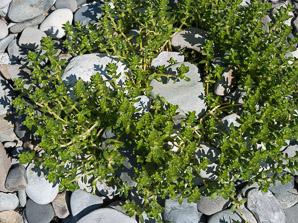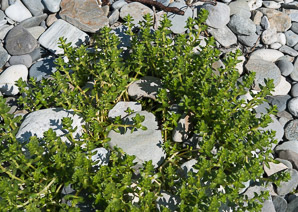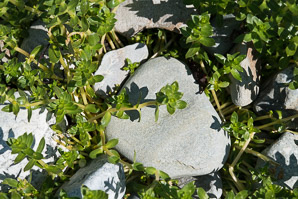
|
Honckenya peploides (L.) Ehrh. Seabeach sandwort
Seabeach sandwort appears in clumps on coastal ocean beach sand, in sand dunes or rocky or gravelly areas. They need full sun. Plants: Low growing plants inhabit sand dunes, forming clumps that are less than 8″ (20 cm) tall, and up to 3′ (1 m) around. Stems may reach 12″ (30 cm) in length, coiling on or near the ground. Leaves: Leaves are succulent, in opposite pairs along each stem. Leaf blades are quite variable: elliptic, ovate, lanceolate or oblanceolate, ⅛-1¾″ (4-46 mm) × 1/32-¾″ (1-20 mm). They have crenate or smooth edges. Flowers: White or greenish-white, ½-¾″ (1.5-2 cm) around, with five petals. They have a strong honey scent. Flowers appear from May to August. Fruits: Roughly ovoid capsules ⅛-⅜″ (5-10 mm) × ⅛-⅜″ (5-12 mm) contain seeds that are 1/16-⅛″ (2-4 mm) around. They appear from July to September. Edibility: Young shoots are edible, raw or cooked. They are harvested prior to flowering and used in baking or as a garnish. However, their diminutive size makes them difficult to obtain. Online References:
Www.centralcoastbiodiversity.org
Honckenya peploides description by Thomas H. Kent, last updated 6 Sep 2021. © FloraFinder.org. All rights reserved. |
6/16/2013 · Birch Point State Park, Owl’s Head, Maine · ≈ 2½ × 1½′ (79 × 53 cm) 6/16/2013 · Birch Point State Park, Owl’s Head, Maine · ≈ 2½ × 1½′ (79 × 53 cm) 6/16/2013 · Birch Point State Park, Owl’s Head, Maine · ≈ 15 × 10″ (37 × 25 cm) Range: Zones 4-8:
|





